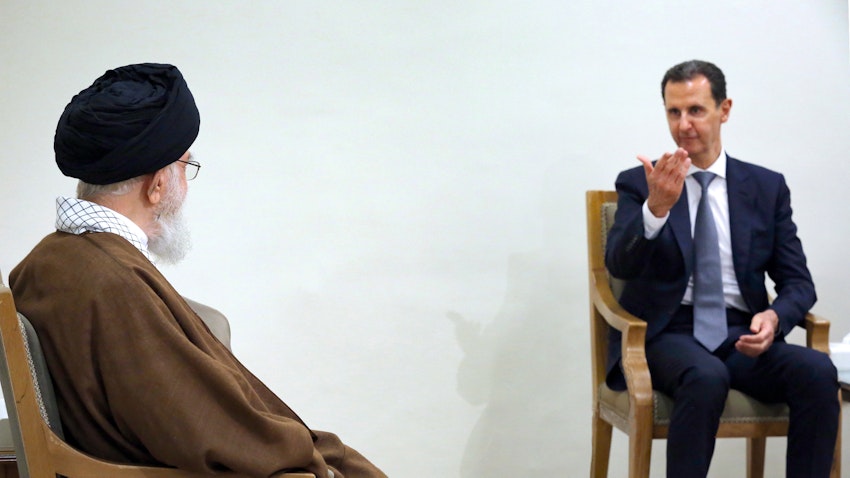Iran’s long-standing alliance with Assad’s Syria, built over decades, was central to its strategy for projecting power in the Middle East. For 13 years, Iran committed vast resources to keep Syrian President Bashar al-Assad in power during the country’s brutal civil war. This alliance was a critical part of Tehran’s “axis of resistance,” a network designed to extend its influence and counter adversaries like Israel and the United States. However, this carefully constructed strategy unraveled dramatically as Assad’s government fell rapidly to rebel forces.
In a matter of days, key Syrian cities such as Aleppo and Hama were overrun, leaving the Assad regime powerless and Iran’s investments in shambles. The collapse caught even Iranian officials off guard. Iran had not only funneled billions of dollars into supporting the Syrian military but also deployed forces and propped up supply lines to ensure its survival. Yet, the Syrian army’s inability to resist advancing rebels stunned Tehran, and even Assad himself appeared unprepared for the speed of the downfall.
Assad’s Fall: Syria’s Unexpected Downfall and Iran’s Strategic Losses
Iran’s concern soon turned to panic as it became clear that the Assad regime was no longer salvageable. Desperate attempts by Iranian officials to rally support from allies like Iraq failed, as regional powers showed little interest in providing further assistance. By the time Iranian diplomats and military personnel began evacuating Damascus, it was evident that Iran’s four-decade-long partnership with Syria was at an end.
Iran’s regional aspirations suffered a serious setback with the fall of the Syrian government. It not only marked the loss of a key ally but also disrupted critical supply routes to Lebanon, where Iran supports Hezbollah. This unravelling raised serious questions about the effectiveness of Tehran’s regional strategy and its ability to maintain influence in a rapidly shifting Middle Eastern landscape.
Assad’s Fall and Hezbollah’s Setback: Regional Impact and Iran’s Struggles
The collapse of the Assad regime came on the heels of another significant setback for Iran: the defeat of Hezbollah in its recent conflict with Israel. Hezbollah, long considered one of Iran’s most formidable allies, suffered heavy losses in the battle. Once a dominant force capable of challenging regional armies, Hezbollah’s power was diminished, and its reputation was tarnished.
This defeat not only weakened Hezbollah but also exposed vulnerabilities in Iran’s broader “axis of resistance.” Iran’s network of proxies, which includes groups in Gaza, Yemen, and Iraq, mobilized in support of Hamas following its attack on Israel in October 2023. Despite these coordinated efforts, the alliance failed to deliver meaningful victories.
Iran’s own actions, such as firing hundreds of ballistic missiles at Israel, also fell short of achieving their goals. Most of the missiles were intercepted by Israeli and allied defenses, and Israel’s retaliation inflicted significant damage on Iran’s military infrastructure, including its advanced air defense systems. Instead of demonstrating strength, these events revealed weaknesses in Iran’s proxy-based strategy, leaving Tehran more vulnerable than before.
Critics argue that Iran’s reliance on proxies has become more of a liability than an asset. The vast resources poured into supporting groups like Hezbollah and Hamas have not translated into strategic gains. Instead, these efforts have drained Iran’s economy and exposed the limits of its influence.
Domestic Criticism and Policy Failures
The swift collapse of Assad’s Syria and Hezbollah’s setbacks sparked a wave of criticism inside Iran. Many Iranians questioned the wisdom of spending billions of dollars on a network that disintegrated so quickly. Critics argued that these resources could have been better used to address domestic challenges and improve the lives of Iranian citizens.
Iranian officials, for their part, tried to downplay the losses. The Foreign Ministry issued a statement emphasizing the historic ties between Iran and Assad’s Syria and expressing hope for continued relations. However, this did little to mask the broader implications of Assad’s fall.
Some analysts pointed to the collapse of Assad’s regime as a failure of Iran’s foreign policy, emphasizing that the support of a nation’s own people is essential for long-term survival. The events in Syria underscored this point, as Assad’s government crumbled under pressure despite Iran’s extensive backing.
In the wake of these events, Iran’s regional strategy lies in tatters. The loss of Syria, combined with the weakening of Hezbollah, represents a significant blow to Tehran’s ambitions. While Iranian officials sought to maintain an optimistic tone, the reality on the ground painted a starkly different picture. Tehran’s strategy of using proxies to project power has suffered a severe and possibly irreparable setback, leaving the region to grapple with the fallout from these dramatic developments.

